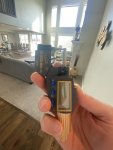I've been reloading for awhile, started with basic RCBS dies and as my level of accuracy increased I moved to Redding S-type bushing dies because I thought they were better. Never had a problem with either. Now I've started looking into getting a 22 Creedmoor and listening to what others have been using as far as bullets, brass, and dies. The topic of a ring of carbon on the brass came up. I believe the person said bushing dies failed to size the brass completely and left a ring of carbon on the neck/shoulder area and was giving him trouble chambering.
Never thought about it before but I guess the bushing would most likely be chamfered a little to allow the neck to enter into the bushing. This would prohibit the brass form being fully sized and could cause some inconsistencies when chambering the round.
True? Thought?
Never thought about it before but I guess the bushing would most likely be chamfered a little to allow the neck to enter into the bushing. This would prohibit the brass form being fully sized and could cause some inconsistencies when chambering the round.
True? Thought?

